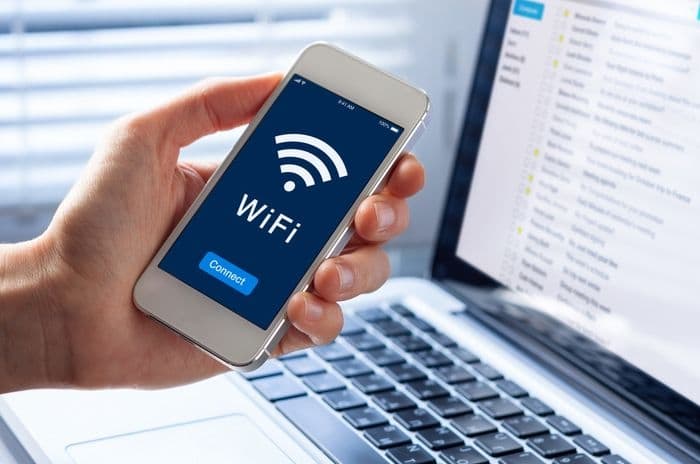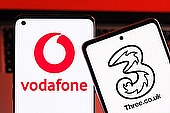The big four of O2, Vodafone, EE and Three offer unlimited tethering on pay monthly and contract SIMs, although there are some caps for pay as you go customers.
Setting up a mobile phone as a hotspot is straightforward, but there are compatibility issues between Android devices and Macs.
Ultimately, using a mobile phone as a hotspot is an excellent way to get online, but users should be aware of pitfalls including battery draining and rapid data usage.

What is tethering?
Tethering is the technical term for turning a mobile phone into a mobile broadband hotspot.
This allows us to connect other phones, tablets and computers to the internet using the original mobile's data signal.
There are other names for tethering that are sometimes used interchangeably such as:
- Mobile hotspot
- Personal hotspot
- Portable hotspot
- Wi-fi hotspot
However, whenever someone talks about connecting another device to the internet using their mobile phone, they're generally referring to tethering.
There are a couple of key things to understand about tethering:
- Customers use the data that's included in their mobile plan, so if this isn't unlimited then the data plan will drain more rapidly.
- Modern tethering is usually wireless, although there are options to physically form a tether by connecting the phone to a computer with a USB cable.
We explore the advantages and disadvantages of tethering later in this guide but let's first look at whether there are tethering limitations on UK mobile networks.
Which mobile networks offer tethering?
Most UK mobile networks allow tethering to a greater or lesser extent, including all the major and minor mobile providers you can compare using Choose's free tool.
However, some have limitations on some plans as the table below demonstrates:
| Tethering allowed? | Rules | |
|---|---|---|
| ASDA Mobile | Yes | Pay monthly: N/A SIM only contract: Unlimited Pay As You Go: Unlimited |
| BT | Yes | Pay monthly: N/A SIM only contract: Unlimited Pay As You Go: N/A |
| EE | Yes | Pay monthly: Unlimited SIM only contract: Unlimited Pay As You Go: 100GB |
| giffgaff | Yes | Pay monthly: Unlimited SIM only contract: Unlimited Pay As You Go: Unlimited |
| iD Mobile | Yes | Pay monthly: Unlimited SIM only contract: Unlimited Pay As You Go: Unlimited |
| Lebara Mobile | Yes | Pay monthly: N/A SIM only contract: Unlimited Pay As You Go: Unlimited |
| Lycamobile | Yes | Pay monthly: N/A SIM only contract: Unlimited Pay As You Go: Unlimited |
| O2 | Yes | Pay monthly: Unlimited SIM only contract: Unlimited Pay As You Go: 100GB |
| Plusnet | Yes | Pay monthly: N/A SIM only contract: 52GB Pay As You Go: N/A |
| Sky Mobile | Yes | Pay monthly: 50GB SIM only contract: 50GB Pay As You Go: N/A |
| Smarty | Yes | Pay monthly: N/A SIM only contract: Unlimited Pay As You Go: N/A |
| Talkmobile | Yes | Pay monthly: N/A SIM only contract: 100Mb Pay As You Go: N/A |
| Tesco Mobile | Yes | Pay monthly: Unlimited SIM only contract: Unlimited Pay As You Go: 100GB |
| Three | Yes | Pay monthly: Unlimited SIM only contract: Unlimited Pay As You Go: Unlimited |
| Virgin Mobile | Yes | Pay monthly: Unlimited SIM only contract: Unlimited Pay As You Go: N/A |
| Vodafone | Yes | Pay monthly: Unlimited SIM only contract: Unlimited Pay As You Go: Unlimited |
| Voxi | Yes | Pay monthly: Unlimited SIM only contract: Unlimited Pay As You Go: N/A |
Major networks offer unlimited tethering on pay monthly or SIM only contracts which, combined with an unlimited data offer or high data allowance, enables customers to use their full allowance on tethering if they wish.
When we look at mobile virtual network operators (MVNOs), the tethering allowances can be smaller, so customers expecting to tether a lot should bear this in mind when comparing mobile deals.
There have been changes to networks' tethering allowances over the years, most notably when Three removed their tethering cap in 2018 following an investigation by Ofcom.
We've also seen mobile networks gradually increase their allowances (especially for pay as you go tariffs), so it's worth double-checking with your network if you're uncertain how much data can be used for tethering.
There's more information on the best unlimited data SIM only deals and what to watch out for in our dedicated guide.
Limited speed plans
Something to note is that a minority of mobile providers including Vodafone, EE and Asda Mobile offer different speed plans.
This means that the speeds available on the tethered device are unlikely to be the fastest available, which might limit the activities that can be undertaken.
Bear in mind, too, that some plans with high data allowances employ speed throttling after a certain amount of data is used every month.
These plans are rarer than they used to be, but some still exist and might catch users out.
Finally, fair use policies on mobile have largely disappeared but if a provider believes the connection is being used for commercial purposes, they could still make a fuss.
This could be if:
- Excessive amounts of data were being used each month
- Many devices are being connected to the mobile hotspot each month
While these caveats may seem worrying, the reality is that customers are going to be fine for everyday tethering as long as they're not trying to run a multi-person office via their mobile phone.
How does tethering work?
Tethering works by broadcasting a mobile phone's signal to use as wi-fi for surrounding devices.
It forms a connection between the mobile and devices attached to its hotspot, with the host mobile having the power to terminate the connection at any time.
Tethering can be activated in three ways: wirelessly, through Bluetooth or via the use of a USB connection.
Tethering wirelessly
Most people opt to turn their mobile phone into a hotspot using wireless technology - and this is supported by the vast majority of handsets.
The tethering feature is built into both Android and iOS devices as standard, although this may not be the case with other operating systems.
Many mobile hotspots will require users to input a password before connecting to the network. This ensures only authorised devices can attach to the hotspot instead of every device in the area having access to it.
There's more detail on how to connect wirelessly to a mobile phone hotspot on Android and iOS below.
Tethering with Bluetooth
Bluetooth can be used to tether a compatible device to a mobile in the same way a Bluetooth speaker or fitness tracker is connected.
This works by pairing the device to another using the Bluetooth function on the phone.
After checking in settings whether Bluetooth is enabled (and switching it on if it isn't), users can scan for other devices in the area and connect the two together.
One benefit of tethering via Bluetooth is that the mobile's battery doesn't drain as quickly because Bluetooth Low Energy (BLE) is used on more modern Bluetooth devices from 4.0 onwards.
Yet there are some downsides of tethering by Bluetooth to be aware of:
- Bluetooth tethering is slower than tethering by wi-fi, although not as slow as it used to be.
- Only one device can be paired at any one time, so the phone won't be able to act as a hotspot for multiple devices at once.
Ultimately, Bluetooth tethering is available on most handsets and it's a great option for connecting one device at a time.
Tethering via USB
Tethering by USB creates a physical tethering connection between a mobile phone and another device, usually a computer.
As it's a physical connection, USB tethering doesn't drain the phone's battery in the same way a wireless connection does, but there are some compatibility issues.
For instance, Android phones can be tethered by USB to Macs. Similarly, while it's possible to tether an iPhone to a PC, it involves having iTunes downloaded on to the PC.
There's also the problem that connecting via USB automatically limits the tethering devices to just the one attached to the mobile phone.
How to tether wirelessly on Android and iOS
The specific process may vary on different models of phone and operating system, but the basics of tethering wirelessly to a phone remain the same across all phone.
On Android devices:
- Go to Settings
- Click on Connections
- Click on option for Mobile Hotspot and Tethering
- Click on Mobile Hotspot
- Turn Mobile Hotspot on
- There will be an option to reveal the password for the device - make a note of this or leave the screen open
- On the connecting device, search for available wi-fi networks, choose the name associated with the mobile and enter the password when prompted
On iOS devices:
- Go to Settings
- Click on Personal Hotspot
- Turn the hotspot on by clicking Allow Others to Join
- The password will be listed on the screen - make a note of it or leave the screen open
- On the connecting device, search for available wi-fi networks, choose the name associated with the mobile and enter the password when prompted
In both cases, it's important to disable the hotspot when it's not in use to avoid unwanted data usage and also to protect the security of the device.
It's possible to change the passwords associated with the device, but make sure it's replaced with a secure one to protect the network and the device itself.
Is tethering secure?
Tethering a computer or other device to a mobile phone is a highly secure method of browsing the internet, especially compared to other options like public wi-fi.
So, for anyone looking to browse the internet while in public, opting for their personal (secured) hotspot is a far safer way to connect than through unsecured public wi-fi.
Key to the security of the tethered connection, however, is the password. Don't be tempted to turn the password option off or change it to something too simple - this is your line of defence against hackers and security threats.
Advantages and disadvantages to tethering
Tethering is an excellent option for connecting to the internet using our mobiles, but there are disadvantages as well as advantages to using tethering technology.
The advantages are:
- Instant internet access for multiple devices wherever a phone has signal
- Safer than public wi-fi
- Often faster and more reliable than popular public wi-fi hotspots
- Wireless tethering allows multiple people and devices to attach to the same hotspot
The disadvantages are:
- A phone's battery drains more quickly when a tether is active
- Often slower than traditional wi-fi
- Data allowances can be used quickly
- There can be operating system compatibility issues
Of these issues, the first one is probably the one that will affect most users: our phone batteries can easily be drained by acting as a hotspot for any other device and this is exacerbated as more devices are added to the hotspot.
It's worth remembering that our data speed will also be shared among the devices attached to the hotspot, meaning slower speeds all round.
This might not be a problem if we're getting 100Mbps+ 5G speeds, but we might notice it on slower 4G connections.
However, overall, tethering is the most popular way for people to get online with their computer or other device. It's straightforward and simple, requiring little technical knowledge to get a tether up and running.
Can tethering replace home broadband?
Tethering to a mobile phone is not usually a viable replacement for home broadband.
The costs of unlimited data plans are more expensive than fixed line broadband, and speeds may be much slower than we're used to from fibre broadband services.
In areas where only slow fixed line speeds are available, it's likely more economical to buy a dedicated 4G or 5G home broadband device. We have more information on mobile broadband for the home here.
The further development of 5G as a home broadband option may also change things in future and make it faster to tether to a mobile.
That said, dedicated home broadband devices will make it easier to manage traffic rather than simply using a mobile phone as a hotspot.
What are the alternatives to tethering?
Since caps on tethering were raised and then mostly eliminated by major networks, tethering has become the standard way for customers to attach other devices to the internet while out and about.
However, many people would prefer not to use their mobile as a hotspot, especially if they're concerned about battery life or data usage.
For those customers, pocket-sized personal hotspot devices or dongles are viable options to get on to the internet.
These come in pay monthly and pay as you go varieties - find out more about mobile wi-fi.
Summary: Great way to get online
Tethering has become a mainstream practice, and there are very few limits compared to previous years.
Yet there are a couple of important points to remember when using tethering to get online:
- Although many networks offer unlimited tethering, there may still be restrictions with some providers so be sure to check
- Tethering can quickly use up a customer's data allowance, especially if we're not on an unlimited plan
- The battery life on mobile phones can be affected by tethering, so bear that in mind and keep a charger nearby
- Phones with larger batteries or more efficient Bluetooth can provide a better tethering experience
With 5G coverage continuing to expand across the UK, it's likely more of us will be using tethering than ever before, accessing speeds far greater than those available on 4G - even if the speeds on the external devices connected to our hotspot will be slower than those available on the mobile phone itself.
To find an unlimited SIM only plan for tethering, compare mobile deals from major operators and smaller names using our free comparison page or read more about whether tethering has replaced the dongle.








